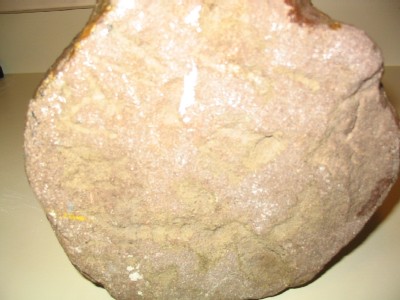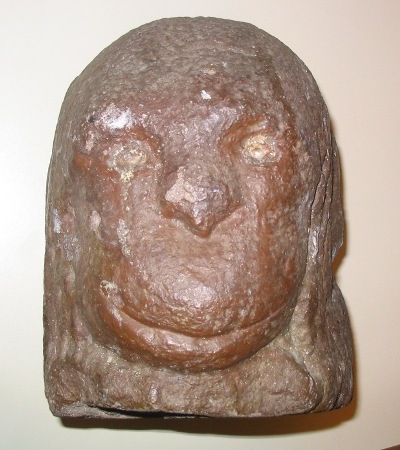Bayer Stone Head Continues
Posted by: Loren Coleman on December 3rd, 2006
This entry adds more information to the December 3, 2006 initial posting on The Bayer Stone Head.
The Bayer Stone Head’s owner, David Chisholm (a military security consultant) shares the following and forwards the photograph of the bottom of the head:
The color is brown paint. William Bayer’s uncle painted it brown. The best estimate to its color is the base. The eyes, William’s uncle cracked a marble and glued the halves in for eyes; they fell out some years ago. I surmised that it is glue residue in the sockets. I had the thought of removing it and started to scratch it out and then had second thoughts so I stopped.
Click image above for a larger view of the bottom of the Bayer Stone Head.
I asked about the possibility of it being placed on display close to his home, so others could observe/examine it. The reply:
I would love to get it on display somewhere. Even if it says modern fake on the display. It does need restoration done by a professional before it gets displayed, i.e. remove the paint and glue residue.
I have the same apprehensions that others do about the head. [As to experts] being able to study it and look at it close up, its worth the expense of travel on my dime to go further.

Ancient Tsimishian carved mask from British Columbia.
Click image for full size version
The Bayer Stone Head, discovered in 1932, in New Paltz, New York; presently located in northern Virginia.
Update: On Sunday, December 3, 2006, Coast to Coast has decided to post the images you saw here yesterday.
About Loren Coleman
Loren Coleman is one of the world’s leading cryptozoologists, some say “the” leading living cryptozoologist. Certainly, he is acknowledged as the current living American researcher and writer who has most popularized cryptozoology in the late 20th and early 21st centuries.
Starting his fieldwork and investigations in 1960, after traveling and trekking extensively in pursuit of cryptozoological mysteries, Coleman began writing to share his experiences in 1969. An honorary member of Ivan T. Sanderson’s Society for the Investigation of the Unexplained in the 1970s, Coleman has been bestowed with similar honorary memberships of the North Idaho College Cryptozoology Club in 1983, and in subsequent years, that of the British Columbia Scientific Cryptozoology Club, CryptoSafari International, and other international organizations. He was also a Life Member and Benefactor of the International Society of Cryptozoology (now-defunct).
Loren Coleman’s daily blog, as a member of the Cryptomundo Team, served as an ongoing avenue of communication for the ever-growing body of cryptozoo news from 2005 through 2013. He returned as an infrequent contributor beginning Halloween week of 2015.
Coleman is the founder in 2003, and current director of the International Cryptozoology Museum in Portland, Maine.












Has any one (like a geologist) determined what type of stone this is made of?
He was wise to not try to remove the glue residue. That could have ruined valuable information about the carved area. I hope he finds a good expert to help, this is interesting.
At the very least, it might show a trading connection between the Tsimishian and the N.E., which would be interesting.
No determinations have been made of any sort, hence the postings. To date the University at New Paltz and the Smithsonia have been contacted, talked to, asked for photographs then declined further study once they saw the pictures.
I am very inpressed with Mr. Chisholm’s honesty as to the history of this item since its discovery. With a person like that owning the item there may be a chance to actually get at the truth. An expert who can identify the stone type is step 1, then a closer look could tell where in the country it originated. This is one I really hope Cryptomundo follows closely. It has real and very interesting possibilities. Please stick with this one.
MOULDED CEMENT FROM A PLASTER MATRIX?
Mr Chisholm may well be as sincere as he seems, but what of those who passed it to him? And even if they’re sincere, how can they be certain of its age, never mind its provenance: they may well be simply mistaken because, afterall, all they know of it is the family legend.
The thing that screams at me as an artist is that this object wasn’t carved, but moulded with, at best, a little light chistling added on after it dried; either that or it was carved by a remarkable sculptor who, paradoxically, had sufficiently terrific chistle control to leave no significant indications of tooling, yet was only capable of producing the lopsided image of what still looks to me like Homer Simpson melting.
It may well be a genuine artifact – a piece by an apprentice, as it were – but its author’d never seen a Bigfoot up close, and must’ve viewed them in generally genial terms.
Following this thread with interest please keep us posted. Surely someone will give some professional opinions.
this reminds me of the situation surrounding the Wabansee stone here in chicago, with some claiming ancient origins while others say a 19th century amateur….
After some research of the area it was found in, I am leaning toward the stone type to be limestone. Will post results once a Geologist has a look and am hoping they can also determine if it was carved with steel tool or something else. That will tell if it is modern or not.
North America has a rich legacy of various “artifacts” associated with some ancient culture long before the time of Columbus. The ancient Israelites have been espcially popular, probably due to certain 19th century religious ideas. Few if any of these objects, most of which are much more sophisticated than this one, can hold up to scrutiny.
Seems like I remember reading about 2 other stone heads in found in Michigan I think. They too were smiling also although rounder-faced as I recall. Could this be a motif that some ancient cultures adapted, perhaps to convey a welcome to visitors?
By the way, I don’t know if there are stone quarries in New York, but where I grew up it wasn’t uncommon for stone masons to carve faces in their spare time. One town here in Indiana is named “Stone Head” and has a marker at the crossroads of a carved face. I remember seeing such carvings at the quarries a half-mile from where I lived. Back before the turn of the 20th century and after, many such carvings were made. So it could be modern.
After eliminating color and bumping up the contrast of the photos, I see a craftsman’s discarded attempt at a head stone to mark a grave. He began with a block, chose a reasonably flat side as the base, and set to work with simple, metal tools. The tool marks, especially those made by a roughing-out, star point chisel are clearly visible on the back side of the head. Perhaps the head was intended as a feature or detail of a much larger monument or grouping of stone objects, owing to the flattened area on the left side of the head. He put some thought into it considering the layout on the right side that strikes a straight line through the shoulder and the chin. Working with a mallet and a star point, this head could have been roughed out in a day’s work or less. I imagine he was not a figurative sculptor, but was asked by a client to give it a try, and so he did. His usual trade of carving grave markers served him well, but he needed some practice. That still leaves one big question: Why the simian look? This was not an accident. A client demanded of the craftsman an authentic-looking Head Stone. I like the idea of the Hear/Speak/See No Evil design. It just fits. I can imagine someone with a fair amount of money to spend asking the craftsman to make a large-scale, three-figured sculpture to mark an important grave or group of graves, maybe even his own. The Monkey Heads would have sat atop much larger stones, perhaps carved from near life size blocks with added details representing ape-like bodies and the requisite flat areas for inscription. But that begs another question: Who might be worthy of such expense, and what had they done to deserve this kind of wit? I think the grave held an important person, someone who knew how to behave in the contentious culture of a 15th to 19th century American village. That describes a politician pretty well, or a clergyman, perhaps. Maybe even a businessman like a financier or an importer. I would suggest searching the region for an existing grave with a finished marker of the type described. I’ll bet there’s more than one.